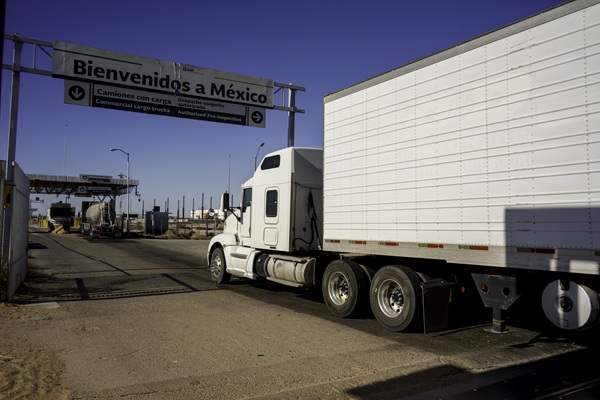
Navigating the 2025 Tariff Landscape: What Transportation Companies Need to Know
The early months of 2025 have brought major uncertainty for transportation and logistics companies, with shifting trade policies and new tariffs creating ripple effects across the supply chain.
While changes in a presidential administration typically bring some policy adjustments, the current tariff landscape has introduced significant complexities for carriers, brokers, and shippers alike. Understanding these changes and preparing for potential impacts will be crucial for supply chain businesses looking to stay ahead.
What tariffs are being implemented?
As of the beginning of March 2025, two key tariff measures have been announced by the Trump administration:
- 20% tariffs on Chinese imports
- 25% tariffs on steel and aluminum
China has also announced various retaliatory tariffs, including several on energy-related products. Proposed 25% tariffs on Canadian and Mexican imports were under negotiation and delayed a month as of Feb. 4. Now that these have been implemented as of March 5, they could further complicate cross-border freight operations and supply chain planning.
How tariffs are impacting transportation
For carriers and brokers, these tariffs could create challenges ranging from equipment costs to shifts in freight demand. Here’s what to watch for:
1. A surge in cross-border freight volumes

Many shippers are accelerating international shipments before tariffs take effect, creating short-term opportunities for carriers but also straining capacity. Texas-to-Mexico border crossings, for example, have seen significant year-over-year growth ahead of possible tariffs.
These surges in volume can lead to congestion at key border points and impact transit times. Rate fluctuations in border markets will require careful planning to optimize margins, and carriers must be strategic in allocating resources to maintain efficiency during these high-demand periods.
2. Higher equipment and maintenance costs
With steel and aluminum tariffs in place, fleets may face price hikes on new trucks and trailers, making it more expensive to expand or replace aging equipment. A Class 8 truck could cost up to $35,000 more due to increased material costs. Maintenance expenses are also rising, as parts sourced from tariff-affected regions become more expensive, leading to higher overall operating costs.
Fleets should reassess procurement strategies, explore alternative sourcing, and increase preventive maintenance efforts to mitigate these added expenses. Proactively managing fleet assets will be essential to controlling costs and maintaining profitability in this evolving landscape.
3. Supply chain shifts and lane adjustments
Certain industries will feel the effects of tariffs more than others, requiring carriers and brokers to adapt. Cross-border auto manufacturing could see disruptions, affecting carriers that specialize in these lanes. Retaliatory tariffs may also slow agricultural shipments to Canada, Mexico, and China, directly impacting outbound U.S. freight.
Additionally, supply chain realignments could shift freight volumes, particularly for mid-sized manufacturers with limited flexibility. Carriers operating in these sectors should anticipate volume fluctuations and adjust strategies to maintain efficiency.
How to stay ahead
Adapting to the changing tariff landscape requires a proactive approach. Transportation providers that embrace strategic planning, strengthen operational efficiencies, and maintain strong shipper relationships will be better positioned to navigate these challenges and capitalize on emerging opportunities.
1. Strengthen cross-border operations
Monitoring volume trends at major crossings is essential for adjusting capacity and staying competitive.
Affected companies could explore transloading options to mitigate exposure to delays at the border, while also forming stronger partnerships with cross-border carriers and customs specialists. These strategic steps will help ensure a smooth flow of goods and minimize disruptions from shifting trade policies.
2. Engage shippers proactively
Keeping shippers informed and offering expert guidance on tariff impacts can strengthen relationships and position transportation providers as trusted partners. By offering contingency planning and ensuring service reliability, companies can maintain strong shipper connections despite market volatility. Prioritizing communication and transparency will help secure long-term business opportunities.
3. Optimize equipment and asset management
Carriers and dual-authority companies should carefully evaluate the timing of new equipment purchases, taking into account potential cost increases due to tariffs. Exploring alternative financing or leasing options can help mitigate rising acquisition costs.
Additionally, assessing part sourcing strategies for maintenance is critical to avoid tariff-driven price fluctuations and potential supply shortages. Proactively managing assets and costs will position companies for financial stability in an uncertain market.
Long-term industry implications
While some tariffs may be temporary, others could drive long-term shifts in freight networks. If new trade policies push for increased domestic manufacturing, regional freight volumes could rise. Carriers with strong U.S. networks and manufacturing-aligned routes may benefit from increased demand and freight density.
Additionally, shippers looking to diversify supply chains may seek expertise in customs compliance, bonded warehousing, and alternative routing strategies, creating new service opportunities for transportation providers.
Turning transportation challenges into advantages
Tariff-related disruptions can be challenging, but they also provide a chance to refine strategies and enhance resilience. By staying proactive and focusing on cost control, capacity management, and shipper collaboration, supply chain companies like carriers and brokers can turn uncertainty into opportunity and strengthen their position in the evolving freight market.
TL;DR
The Trump administration’s 2025 tariffs—20% on Chinese imports, 25% on steel/aluminum, and 25% on Canadian/Mexican imports (implemented March 5)—are creating major challenges for transportation companies. Key impacts include: (1) surge in cross-border freight as shippers rush shipments before tariffs take effect, creating short-term opportunities but straining capacity, (2) higher equipment costs with trucks potentially costing $35,000 more due to steel/aluminum tariffs, plus increased maintenance expenses, and (3) supply chain shifts affecting auto manufacturing lanes and agricultural exports due to retaliatory tariffs. Transportation companies should strengthen cross-border operations through volume monitoring and transloading, engage shippers proactively with tariff guidance and contingency planning, and optimize equipment timing while exploring alternative financing. Long-term implications include potential domestic manufacturing growth benefiting U.S.-focused carriers and new opportunities in customs compliance and alternative routing services.



